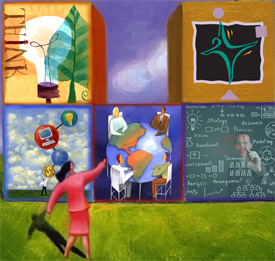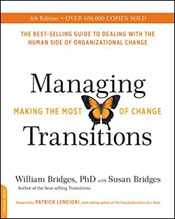
Bad, Wrong, or Stupid: How Not to Influence
B. Kim Barnes
 “How can you believe a thing like that?” “That’s
completely irrational.” “You’ve joined the lunatic
fringe, I see.” “If everyone thought/ dressed/ acted/ voted
that way, we’d be in big trouble.”
“How can you believe a thing like that?” “That’s
completely irrational.” “You’ve joined the lunatic
fringe, I see.” “If everyone thought/ dressed/ acted/ voted
that way, we’d be in big trouble.”
How many times in the past few months have we wanted to say something like that to a friend, a relative, or a colleague? Whether the topic is politics, business, fashion, or even the choice of which sports team to support, it’s difficult to imagine that a person we work with, like, or are related to can possibly see the world so differently from the way we do. Family ties, friendships, and working relationships can be strained or even broken by the way we react to one another’s opinions and actions. A lot has been written recently about how “tribal” we have become: living in a bubble or an echo chamber, watching, listening to and reading the media that aligns with and reinforces our own opinion. We try to avoid difficult conversations – which may mean avoiding speaking with people with whom we assume we will disagree.
In this new world of “alternative facts,” people on each side of a dispute or difference feel entitled to their own truth. More than ever before, taking it for granted that we start with a common data set with another can lead to confusion and miscommunication. It also can lead to escalation; moving rapidly from discussion to argument to personal conflict, featuring an attack-defend spiral. Once this process begins, it becomes difficult, even impossible, to influence one another.
The more we spend time with like-minded others, staying within our comfort zone, the less conflict we experience, the more supported we feel, and the less likely we are to question ourselves, to learn anything or to change anyone’s mind.
In our Constructive Debate workshop, we begin by asking participants to consider how they and others reach conclusions. We distinguish among three types of statements or self-talk: facts, values, and assumptions.
- Facts are data that can be objectively observed.
- Values are beliefs about what is right, wrong, good, or bad.
- Assumptions are the inferences we make and the meaning we then assign to the data we have selected to pay attention to, often informed by our values.
In the past, most disagreements have been based on values or assumptions. In this new and more complex environment, we also fight about the facts.
Many disagreements are played out through mutual attempts at persuasion, but since the parties often don’t share a common set of facts, these conversations go nowhere – or quickly downhill. Ad hominem arguments prevail. (“You’re just so stupid/ prejudiced/ uninformed/ manipulated/ selfish that you can’t see the truth staring you in the face!”) It’s a natural response to what seems like an inability on the part of the other to face what you believe to be reality.
So…how well does that work for you? As brain scientists and behavioral economists have demonstrated, the least likely strategy for getting someone to agree with you is to put them on the defensive, to make them feel attacked and labeled bad, wrong, or stupid. Once the wall of defense goes up, we tend to become more and more firmly fixed behind it, stuck in our own position, unable to consider other possibilities while we feel under threat.
So how can we influence someone who has a different set of facts, values, or assumptions than yours? The ancient Greek philosopher, Epictitus, is credited with the quote, “We have two ears and one mouth so that we can listen twice as much as we speak.” That’s good advice, but difficult to follow when your emotions are threatening to overcome your rationality.
More effective self-talk can save these situations from spinning out of control. Instead of focusing on how wrong the other person is, you can turn on your curiosity. Rather than telling yourself, “What an idiot. Why should I waste my time on him/her/them?” You might try, “Hmmm. That’s really interesting. I wonder how this person reached that conclusion, so different from mine.” You can then ask, with real interest – not just fishing for statements that you can then destroy with your superior logic – questions that might help you understand the other. You can withhold judgment for long enough to reduce suspicion. You don’t have to agree, but you can begin to remove a few bricks from the walls each of you has built. Over time, if you demonstrate interest, listen non-judgmentally, and begin to identify areas of common ground, you create an atmosphere in which mutual influence can take place. (And remember, influence is a two-way process!)
Public Programs for 2017
We have updated our public program schedule:
 Exercising Influence
Exercising Influence
May 18, 2017
July 11, 2017
October 17, 2017
Managing Innovation
May 16, 2017
Strategic Thinking
June 27, 2017
Consulting on the Inside
July 12, 2017
All the above programs are being offered in Berkeley, California. Cost is $795.
Exercising Influence and Managing Innovation are being offered by our global partner in France, and Exercising Influence and Strategic Thinking are being offered by our Canadian partner as well.
Visit our website for the full schedule worldwide
Conversations About Influence: A New Podcast Series
 We’ve created a series of six podcasts on the subject of influence,
drawn from a wide-ranging conversation with Barnes & Conti CEO Kim
Barnes, joined by Allan Cohen and Mary Walter.
We’ve created a series of six podcasts on the subject of influence,
drawn from a wide-ranging conversation with Barnes & Conti CEO Kim
Barnes, joined by Allan Cohen and Mary Walter.
Allan Cohen, Ph.D., is Edward Madden Professor of Global Leadership at Babson College. He is the co-author with David Bradford of Influence Without Authority, 2nd Edition (Wiley, 2005) and is currently preparing the third edition for publication.
Mary Walter, President of Mary Walter Leadership, is a leadership coach and an expert in team effectiveness. Mary has over 20 years of experience as a senior executive and leader in retail store operations, most recently at Ross Stores, and has now launched her own consulting firm.
As most of you know, B. Kim Barnes is is the CEO of Barnes & Conti and author of Exercising Influence: Making Things Happen at Work, at Home, and In Your Community, 3rd Edition (Wiley, 2015), among other publications.
Podcast topics range from influence and gender stereotypes to the role of confidence in influence success to the pros and cons of interrupting—and how to do it successfully! Other topics include influencing remotely, influencing within teams, and establishing a healthy climate for influence. Although the conversation was spontaneous, we found that it moved through several topics all related to influence so we divided it as follows:
- Part 1: Introductions, gender stereotypes about influence and how to deal with them
- Part 2: Confidence: how to gain it and how it relates to your ability to influence
- Part 3: Pros and cons of interrupting: how to do it respectfully and successfully to enter an influence conversation, how to deal with it when others do it to you
- Part 4: Influencing remotely: how to make global teams and team meetings more successful and influence-friendly
- Part 5: Influencing in a team: particularly peer-to-peer
- Part 6: How to establish a healthy climate for influence in your team and your organization.
We hope you enjoy listening to the podcast series and that you’ll continue the conversation by sending us your thoughts about the topics.
Watch your email for notifications of the rest of this series, and/or bookmark this link: http://barnesconti.com/podcasts/influence.html
Upcoming Events: Mark Your Calendars!
Kim Barnes to Present on Internal Consulting at AIMC
Kim Barnes will be presenting a keynote address and a workshop, both entitled, “The Influential Consultant” at the AIMC (Association of Internal Management Consultants) 2017 International Conference in Lake Buena Vista (Orlando), Florida. The keynote will be presented on May 2, 2017, 2:30 – 3:45 pm. The workshop is on May 3, from 8:30 am until noon.
Both keynote and workshop are based on Kim’s research and practical learnings on how internal consultants and others in advisory positions within an organization can increase their success with both their project teams and other client relationships and also influencing upward with corporate executives/sponsors for broader organizational impact.
More information and registration for AIMC
UC People Management Conference in August: Workshops on Influence, Innovation, and Problem-Solving
This August, Kim Barnes will be leading three workshops at the first annual University of California People Management Conference, to be held August 1 – 3 at the UCLA Luskin Conference Center in Los Angeles, CA. The workshops are entitled:
- Exercising Influence: An Introduction
- Managing Innovation: An Introduction
- Puzzles, Mysteries, and Muddles: An Introduction
This conference is open to alumni of the University of California’s management and leadership program.
For more information, please visit the conference website.
Books by Barnes & Conti Associates and Friends
Shift Into Thrive: Six Strategies for Women to Unlock the Power of Resiliency
 Barnes & Conti Executive Associate Kevin Nourse, Ph.D. recently
co-authored this book with Lynn Schmidt. Here’s what the publisher has
to say:
Barnes & Conti Executive Associate Kevin Nourse, Ph.D. recently
co-authored this book with Lynn Schmidt. Here’s what the publisher has
to say:
Schmidt and Nourse each have over 20 years of experience helping women and men achieve career success. They are experts in the field of leadership development and provide leadership strategies to individuals, teams, and organizations. They conducted over one hundred interviews with executive coaches and women from around the world to determine the best resilience-building strategies for women...
Shift Into Thrive is an exciting new addition to a genre of books dedicated to helping women achieve successful and satisfying careers...
In addition to Kevin’s work of consulting and facilitating for Barnes & Conti, he an executive coach, leadership researcher, speaker, and adjunct professor with a passion for helping leaders and managers resiliently navigate change and adversity. He focuses his professional practice on the development of women leaders, particularly in healthcare professions.
Managing Transitions, 25th anniversary edition: Making the Most of Change
 This classic book on change management by the late Dr. William Bridges
was recently updated by Susan Bridges to introduce this work to both
a new generation and a business environment characterized by more and
more volatile change. The publisher saspring2017Textys:
This classic book on change management by the late Dr. William Bridges
was recently updated by Susan Bridges to introduce this work to both
a new generation and a business environment characterized by more and
more volatile change. The publisher saspring2017Textys:
This indispensable guide is now updated to reflect the challenges of today’s ever-changing, always-on, and globally connected workplaces. Directed at managers on all rungs of the corporate ladder, this expanded edition of the classic bestseller provides practical, step-by-step strategies for minimizing disruptions and navigating uncertain times.
Like this newsletter?
Subscribe now!
For more valuable information and special offers, follow us!
In this Issue:
- “Bad, Wrong, or Stupid: How Not to Influence”
B. Kim Barnes - Public Programs for 2017
- Conversations About Influence: A New Podcast Series
- Upcoming Events: AIMC and UC People Management Conference
- Books by Barnes & Conti Associates and Friends
- Featured Art: “The Political Argument,” by Charles Spencelayh
- Recipe: Seafood Paella
Upcoming Public Programs: Innovation and Influence
![]()
Managing Innovation
May 16 in Berkeley, CA
In Managing Innovation, you will discover
and practice the mindsets and skill-sets needed to increase both the
quality and quantity of innovation.
![]()
Exercising Influence
May 18 in
Berkeley, CA
Exercising Influence will help you build the relationships necessary to get positive results up, down, and across your organization.
![]()
Strategic
Thinking
June 27 in Berkeley, CA
Strategic Thinking integrates critical thinking, systems thinking, and creative thinking to help you become a more future-focused leader.
![]()
Consulting
on the Inside
July 12 in Berkeley, CA
Consulting on the Inside will help you to develop a greater understanding of your role, the consulting process itself, and how to use specific communication skills and tools to create an effective and successful internal consulting practice.
Cost for each: $795
Click here to register.
Barnes & Conti ATD 2017 Expo
Barnes & Conti is excited to be participating again in the ATD 2017 Conference in Atlanta, May 21-24. Please e-mail Lauren Powers if you will be attending so we can arrange to meet up.
You can find us visit us at Booth 1210.
For complimentary EXPO only registrations follow this link
When prompted, enter 1032 as the Invite Id

Recipe: Seafood Paella

Lauren Powers, SVP of Business Development says, “Our family loves seafood paella. It is a favorite at the beach where scallops from Viking Village in Barnegat Light are right off the boat.”
“My love for this dish started when we visited the famous Victor’s Café in NYC with my sister in the early 80’s and then I realized we had an even better Spanish restaurant right down the street from our NYC apartment, Malaga. Known for its authenticity, we loved celebrating all occasions and most of all, New Years’ Eve, when the kitchen help would bang pots and pans as the clock struck midnight. For all the times I visited, I always ordered the same dish…. Mariscada al Ajillo, a seafood paella. (Unfortunately, Malaga closed in 2012 after being cited by the Department of Health, so sad!)”
“We have recreated our own version of this dish at home based on an adaptation of a recipe for Arroz con Pollo. This dish feeds a lot of people and always impresses! And, it makes a great cold picnic lunch on the beach the next day served in red solo cups.”
You can get creative and throw in corn and/or defrosted frozen chopped and sautéed artichokes instead of peas for a change.
Ingredients:
- 1 lb large shrimp, peeled, deveined and cut in half
- 2 dozen littleneck clams
- 1/3 lb scallops, (broken ones work well and are much cheaper)
- Olive oil
- 1 cup of white wine to cook clams in
- 1 cup onion, chopped
- 1 tsp minced garlic
- 1 red pepper, chopped
- 1 tomato, chopped
- 1/2 tsp saffron
- 1/2 cup white wine
- A handful of fresh parsley, chopped
- 1 cup Carolina long grain rice
- 1 bay leaf
- 1 1/4 cup chicken broth
- 1 tbsp fresh lemon juice
- 1/4 tsp dried red pepper flakes
- 1/2 cup cooked peas
- 1/2 cup defrosted frozen artichokes, chopped (optional, instead of peas)
- 1 can corn or frozen kernels (optional, instead of peas)
Method:
- 1. Sauté onion, peppers, garlic in olive oil.
- Add rice and stir to coat.
- Add saffron, tomatoes, chopped parsley, 1/2 cup white wine, tomato, broth and bay leaf, lemon juice, pepper flakes and salt and pepper to taste.
- Bring to a boil and then cover and simmer for about 18 minutes.
- While rice is cooking, sauté shrimp in olive oil and 1/2 tsp minced garlic. Remove and sauté scallops for a couple of minutes on each side and remove from pan.
- Sauté 1 tsp of garlic and add 1 cup of wine. Add clams and cover. Heat until all shells open,
- In last few minutes of rice cooking, add peas or artichokes and corn.
- Add more hot broth if you need it to soften rice.
- Add shrimp and scallops to rice and mix.
- Add clams.
- Serve with crusty bread and salad.
You are receiving these emails from Barnes & Conti because you are a client, colleague, and/or friend of Barnes & Conti Associates. or you contacted us through our website, at a trade show, or via social media. Barnes & Conti does not sell, trade, or give away mailing lists or email addresses to anyone. Period.
If you no longer wish to receive these bulletins, use this link to unsubscribe or write us at Barnes & Conti, 940 Dwight Way Suite 15, Berkeley, CA 94710.
*Please don't forward this entire email; the person you forward to might inadvertently unsubscribe you with the above link!